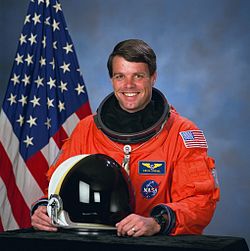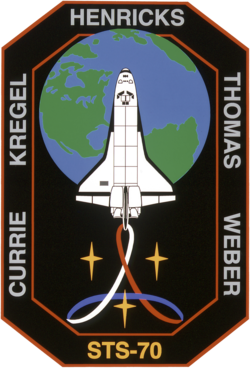Kevin R. Kregel
| Kevin R. Kregel | |
|---|---|
 | |
| Land | USA |
| Organisation | NASA |
| ausgewählt | 31. März 1992 (14. NASA-Gruppe) |
| Einsätze | 4 Raumflüge |
| Start des ersten Raumflugs | 13. Juli 1995 |
| Landung des letzten Raumflugs | 22. Februar 2000 |
| Zeit im Weltraum | 52d 18h 21min |
| ausgeschieden | 27. Juni 2002 |
| Raumflüge | |
Kevin Richard Kregel (* 16. September 1956 in New York City, New York) ist ein ehemaliger US-amerikanischer Astronaut.
Ausbildung
Kregel erhielt 1978 einen Bachelor in Raumfahrttechnik von der United States Air Force Academy und 1988 einen Master in Öffentlicher Verwaltung von der Troy State University.
Bei der US Air Force machte Kregel 1979 seinen Pilotenschein. Von 1980 bis 1983 war er als F-111-Pilot auf dem Flugfeld Lakenheath in England stationiert. Als Austauschoffizier flog er die A-6E auf dem Navy-Stützpunkt Whidbey Island in Seattle und absolvierte 66 Flugzeugträgerlandungen auf der Kitty Hawk im Westpazifik. Nach seiner Ausbildung zum Testpiloten erprobte er verschiedene Flugzeug- und Waffensysteme auf der Eglin Air Force Base in Florida.
Astronautentätigkeit
Im April 1990 wurde er von der NASA als Luft- und Raumfahrtingenieur und Pilotenausbilder angestellt. Auf dem Flughafen Ellington Field arbeitete er als Pilotenausbilder mit den Shuttle Training Aircraft und testete Verbesserungen am T-38-Jet der NASA.
Im März 1992 wurde Kregel von der NASA als Astronautenanwärter ausgewählt und zum Space-Shuttle-Piloten ausgebildet. Er war Mitglied der Unterstützungsmannschaften am Kennedy Space Center und arbeitete als Verbindungssprecher (Capcom). Er war Mitglied des Space Launch Initiative Project am Engineering Directorate am Johnson Space Center.
Am 13. Juli 1995 startete Kregel als Pilot der Raumfähre Discovery zu seiner ersten Mission ins All. Hauptaufgabe war das Aussetzen des Relaissatelliten TDRS-G.
Bei seinem zweiten Einsatz flog Kregel am 20. Juni 1996 mit der Raumfähre Columbia zu dem bis dahin längsten Flug eines Space Shuttles (16d 21h 48min). Aufgabe waren Schwerelosigkeitsexperimente im Life and Microgravity Spacelab (LMS), die als Grundlage für zukünftige Experimente auf der Internationalen Raumstation (ISS) benötigt wurden.
Am 19. November 1997 startete Kregel als Kommandant der Columbia zur Spacelab-Mission „United States Microgravity Payload 4“. Dabei führten die beiden Missionsspezialisten Winston Scott und Takao Doi zwei Weltraumausstiege (EVAs) durch. Bei der ersten EVA fingen sie den zu Beginn des Fluges ausgesetzten Forschungssatelliten SPARTAN ein, der in ein unkontrolliertes Taumeln geraten war. Außerdem erprobte man erstmals die sogenannte AERCam, eine etwa 40 Zentimeter große Kugel, die mit einem Lageregelungs- und einem Kamerasystem ausgestattet, schwer zugängliche Strukturen erkunden kann. Scott ließ ihn aus der Nutzlastbucht schweben und Steven Lindsey kontrollierte AERCam mittels Fernbedienung vom Cockpit aus.
Am 11. Februar 2000 flog Kregel als Kommandant des Space Shuttles Endeavour zur sogenannten Shuttle Radar Topography Mission. Dabei kartografierte er mittels Radar 80 Prozent der Landmasse der Erde. Zwei Radarsysteme (eines in der Nutzlastbucht des Shuttles, das andere an einem 60 Meter langen Mast montiert) tasteten die Erdoberfläche ab. Das Resultat war ein digitales dreidimensionales Modell der Erde von bisher nicht gekannter Genauigkeit. Um ein Arbeiten rund um die Uhr zu ermöglichen, war die sechsköpfige Besatzung in zwei Teams aufgeteilt, die im 12-Stunden-Betrieb arbeiteten. Kregel bildete mit den Missionsspezialisten Janet L. Kavandi und Gerhard Thiele das rote Team.
Nach der NASA
Zurzeit ist er Pilot bei Southwest Airlines.
Privates
Kevin Kregel ist verheiratet und hat vier Kinder.
Siehe auch
Weblinks
- Kurzbiografie von Kevin R. Kregel bei spacefacts.de
- NASA-Biografie von Kevin R. Kregel (englisch; PDF)
- Biografie von Kevin R. Kregel in der Encyclopedia Astronautica (englisch)
| Personendaten | |
|---|---|
| NAME | Kregel, Kevin R. |
| ALTERNATIVNAMEN | Kregel, Kevin Richard |
| KURZBESCHREIBUNG | US-amerikanischer Astronaut |
| GEBURTSDATUM | 16. September 1956 |
| GEBURTSORT | New York City, New York |
Auf dieser Seite verwendete Medien
The STS-78 patch links past with present to tell the story of its mission and science through a design imbued with the strength and vitality of the 2-dimensional art of North America's northwest coast Indians. Central to the design is the space Shuttle whose bold lines and curves evoke the Indian image for the eagle, a native American symbol of power and prestige as well as the national symbol of the United States. The wings of the Shuttle suggest the wings of the eagle whose feathers, indicative of peace and friendship in Indian tradition, are captured by the U forms, a characteristic feature of Northwest coast Indian art. The nose of the Shuttle is the strong downward curve of the eagle's beak, and the Shuttle's forward windows, the eagle's eyes, represented through the tapered S forms again typical of this Indian art form. The basic black and red atoms orbiting the mission number recall the original NASA emblem while beneath, utilizing Indian ovoid forms, the major mission scientific experiment package LMS (Life and Materials Sciences) housed in the Shuttle's cargo bay is depicted in a manner reminiscent of totem-pole art. This image of a bird poised for flight, so common to Indian art, is counterpointed by an equally familiar Tsimshian Indian symbol, a pulsating sun with long hyperbolic rays, the symbol of life. Within each of these rays are now encased crystals, the products of this mission's 3 major, high-temperature materials processing furnaces. And as the sky in Indian lore is a lovely open country, home of the Sun Chief and accessible to travelers through a hole in the western horizon, so too, space is a vast and beckoning landscape for explorers launched beyond the horizon. Beneath the Tsimshian sun, the colors of the earth limb are appropriately enclosed by a red border representing life to the Northwest coast Indians. The Indian colors of red, navy blue, white, and black pervade the STS-78 path. To the right of the Shuttle-eagle, the constellation Delphinus recalls the dolphin, friend of ancient sailors and, now perhaps too, of the 9 space voyagers suggested by this constellation's blaze of 9 stars. The patch simultaneously celebrates international unity fostered by the Olympic spirit of sports competition at the 1996 Olympic Games in Atlanta, Georgia, U.S.A. Deliberately poised over the city of Atlanta, the Space Shuttle glows at its base with the 5 official Olympic rings in the 5 Olympic colors which can also be found throughout the patch, rings and colors which signify the 5 continents of the earth. This is an international mission and for the first time in NASA patch history, astronauts have dispensed with identifying country flags beneath their names to celebrate the spirit of international unity so characteristic of this flight.
The STS-87 patch is shaped like a space helmet symbolizing the Extravehicular Activity (EVA) on the mission in support of testing of tools for the assembly of the International Space Station (ISS). Earth is shown reflected on the backside of the helmet. The Space Shuttle Columbia forms the interface between the Earth and the heavens, the back and front sides of the helmet in profile. The three red lines emerging from Columbia represent the astronaut symbol as well as the robot arm, which was used to deploy and retrieve the Spartan satellite.
The text 'µg' represents the payloads studying microgravity science in space on this United States Microgravity Payload (USMP-4) mission. Gold flames outlining the helmet visor represent the corona of the Sun, which will be studied by Spartan. The flag of Ukraine is next to the name of the payload specialist who is the first person from that nation to fly on the Space Shuttle.
STS099-(S)-001 (JUNE 1999) STS-99 INSIGNIA -- The crew members designed the flight insignia for the Shuttle Radar Topography Mission (SRTM), the most ambitious Earth mapping mission to date. Two radar antennas, one located in the Shuttle bay and the other located on the end of a 60-meter deployable mast, will be used during the mission to map Earth's features. The goal is to provide a 3-dimensional topographic map of the world's surface up to the Arctic and Antarctic Circles. The clear portion of Earth illustrates the radar beams penetrating its cloudy atmosphere and the unique understanding of the home planet that is provided by space travel. The grid on Earth reflects the mapping character of the SRTM mission. The patch depicts the Space Shuttle Endeavour orbiting Earth in a star spangled universe. The rainbow along Earth's horizon resembles an orbital sunrise. The crew deems the bright colors of the rainbow as symbolic of the bright future ahead because of human beings' venturing into space.
STS-70 Mission Insignia
The STS-70 crew patch depicts the Space Shuttle Discovery orbiting Earth in the vast blackness of space. The primary mission of deploying a NASA Tracking and Data Relay Satellite (TDRS) is depicted by three gold stars. They represent the triad composed of spacecraft transmitting data to Earth through the TDRS system. The stylized red, white, and blue ribbon represents the American goal of linking space exploration to the advancement of all humankind.
Astronaut Kevin R. Kregel, mission commander




